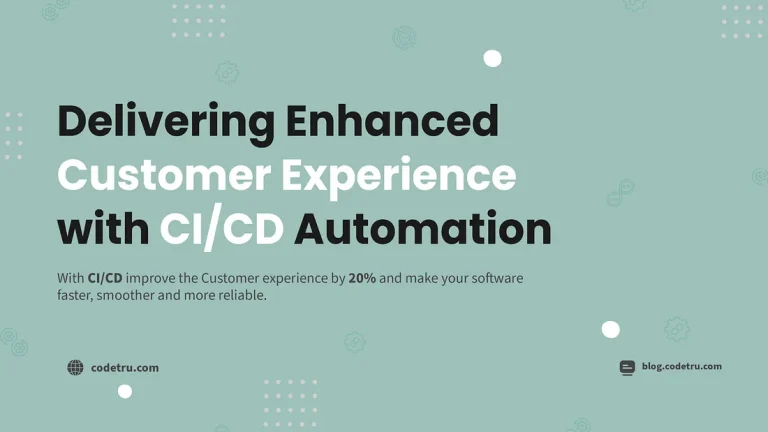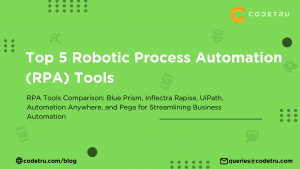In today’s fast-paced digital landscape, staying competitive means not only delivering top-notch products and services but also ensuring a seamless and delightful customer experience (CX). Which is why high-quality software development is the key and bringing automation is critical. Therefore, Continuous Integration and Continuous Delivery (CI/CD) automation has emerged as a game-changer in achieving these goals.
CI/CD automation is a software development practice that focuses on automating the processes of building, testing, and deploying software. It streamlines and accelerates the development pipeline, making it possible to deliver updates and improvements more rapidly and reliably enhancing the overall CX.
Benefits of CI/CD Automation
1. Faster Delivery, Higher Satisfaction
Statistics show that companies implementing CI/CD automation report a staggering 63% improvement in customer satisfaction. By reducing the time it takes to roll out new features and fixes, customers get access to improved products and services faster. This swift response to their needs and preferences leads to increased satisfaction.
2. Reducing Time to Market and Boosting Retention
The impact of CI/CD automation on the bottom line is significant, with a 50% reduction in time to market and a 23% increase in customer retention. This means that not only can you deliver new features quicker, but you can also keep your customers coming back for more.
3. Increasing Revenue and Decreasing Costs
CI/CD automation isn’t just about delivering a better CX; it’s also good for business. Companies adopting CI/CD automation report a 20% increase in revenue and a 15% decrease in costs. These figures highlight the potential for substantial growth and efficiency gains.
Enhancing CX Throughout the Customer Journey
With any product or service, providing your customers with a smooth experience at every stage comes at top.
Now that we understand the benefits, let’s delve into how it can improve CX at various stages of the customer journey.
Awareness Stage
- In the awareness stage, CI/CD automation helps create a positive first impression by ensuring a high-quality website and mobile app experience. Automated testing tools can detect and fix bugs, errors, and usability issues, guaranteeing a smooth initial interaction. Additionally, feedback and analytics tools help monitor and improve loading speed, design, and navigation. With several A/B testing tools available, the process of choosing the best version of website & mobile app becomes qualitative as well as quantitative.
Consideration Stage
During the consideration stage, building trust and credibility is paramount. CI/CD automation can help you do this for potential customers by providing consistent and relevant information and content across different channels in the following ways:
- Consistency: CI/CD automation ensures that all information and content is published consistently across all channels, regardless of the team or individual responsible for publishing it. This helps to create a sense of trust and reliability with potential customers, who can be confident that they are always getting the most up-to-date and accurate information.
- Relevance: CI/CD automation can be used to target specific audiences with information and content relevant to them. This can be done by segmenting audiences based on their interests, demographics, or other factors.
- Personalization: CI/CD automation can also be used to personalize information and content for individual potential customers. This can be done by using data from the customer’s interactions with the company, such as their website visits or purchase history and using it to enhance their present future experiences.
Some of the ways CI/CD automation can provide a personalized and engaging customer experience are:
- Content management systems (CMS) simplify content creation and updates
- Marketing automation tools segment and target customers based on their interests.
- Chatbots and AI tools provide instant and accurate answers to queries, enhancing engagement.
Some of the big names such as Netflix, Amazon and Spotify are using CI/CD to provide their customers with an immersive experience.
Purchase Stage
It is the most crucial step in the customer journey. CI/CD can make this process a lot smoother for the customer by:
Frequent Updates: With CI/CD, updates can be made frequently, ensuring that the checkout process is always equipped with the latest features and security updates.
Automated Testing: Automated testing is a crucial part of CI/CD. It ensures that any new changes or updates do not break the existing functionality of the checkout process.
Faster Issue Detection and Resolution: CI/CD allows for faster detection of issues in the checkout process. If an issue is detected, it can be resolved quickly, minimizing any potential disruption to the customer’s purchase process.
Improved Performance: Continuous monitoring in CI/CD can help identify performance bottlenecks in the checkout process. These can then be addressed to ensure that the checkout process is as fast and efficient as possible.
Better Security: CI/CD can help improve security by automatically checking for vulnerabilities in the codebase. Any detected vulnerabilities can be quickly addressed, ensuring that the checkout process is secure for customers.
Streamlining the purchase process is vital for customer satisfaction. CI/CD automation optimizes the checkout experience with payment gateway integration tools offering multiple payment options and reducing errors and fraud. Order management systems (OMS) efficiently track and manage orders, and email marketing tools send timely notifications, reassuring customers.
Retention Stage
Customer Retention not only shows that your customers are happy with your service or product, it also greatly reduces the cost of acquiring new customers.
Furthermore, it also ensures that you have lesser chance of losing your customers to competition.
To retain and delight existing customers, CI/CD automation offers continuous support and value after the purchase. Customer service platforms (CSP) handle complaints, feedback, and reviews promptly. CRM tools maintain regular communication, offer personalized recommendations, and measure product usage and quality.
CI/CD can assure Customer Satisfactions and eventually customer retention in a few ways:
- Frequent Updates and New Features: CI/CD allows for regular software updates, which means customers can benefit from new features and improvements on a continuous basis. This constant delivery of value can increase customer satisfaction and loyalty.
- Customer Feedback: CI/CD supports the implementation of customer feedback into the product quickly, making customers feel heard and valued.
- Stability and Security: Regular updates not only bring new features but also patch security vulnerabilities, ensuring the application remains secure and stable.
Conclusion
In conclusion, CI/CD automation is a game-changer for enhancing CX in various stages of the customer journey. Its ability to deliver faster, better, and more reliable products and services benefits both businesses and customers. Increased loyalty, satisfaction, and advocacy, along with improved market share, revenue, and profitability, are just some of the rewards.
To succeed in implementing CI/CD automation effectively, choose the right tools, align your teams around a common vision, and regularly test and iterate your processes based on customer feedback and data. By optimizing your CI/CD practices for CX, you can stay ahead in the competitive world of digital business.
Incorporating CI/CD automation into your development process is not just a technological shift; it’s a strategic move toward delivering an exceptional customer experience that keeps your customers coming back for more.
5 FAQs on Delivering Enhanced Customer Experience with CI/CD Automation
1. What is CI/CD automation and how does it improve customer experience?
CI/CD automation refers to Continuous Integration and Continuous Deployment practices that streamline the software development process. By automating the integration, testing, and deployment of code changes, CI/CD ensures that new features and updates are delivered quickly and reliably. This improves customer experience by providing users with frequent updates, faster bug fixes, and more consistent performance, all of which contribute to a more satisfying and seamless interaction with the software.
2. How does Continuous Integration (CI) contribute to better software quality?
Continuous Integration (CI) involves automatically integrating code changes into a shared repository frequently, often multiple times a day. This practice ensures that code is continuously tested and validated, catching errors early in the development process. By maintaining high code quality and reliability, CI helps deliver a smoother and more reliable user experience, reducing the likelihood of bugs and performance issues for end-users.
3. What role does Continuous Deployment (CD) play in enhancing user satisfaction?
Continuous Deployment (CD) automates the process of releasing software updates to production environments. By enabling frequent and automated deployments, CD ensures that users receive new features, enhancements, and bug fixes quickly. This rapid deployment cycle enhances user satisfaction by keeping the software up-to-date and responsive to user needs, addressing issues promptly, and delivering new capabilities without long delays.
4. How can CI/CD automation help in responding to customer feedback?
CI/CD automation facilitates quick and efficient updates to software based on customer feedback. With automated testing and deployment pipelines, development teams can rapidly implement and release changes in response to user suggestions or reported issues. This agility allows businesses to address customer needs and preferences more effectively, leading to improved user satisfaction and engagement.
5. What are the benefits of integrating CI/CD with other tools for customer experience management?
Integrating CI/CD automation with customer experience management tools enhances the overall process of delivering software updates. Tools such as monitoring systems, analytics platforms, and customer feedback solutions can be integrated into the CI/CD pipeline to provide real-time insights into user interactions and performance. This integration allows teams to quickly identify and address issues, optimize features based on user data, and ensure that updates align with customer expectations, ultimately enhancing the user experience.







